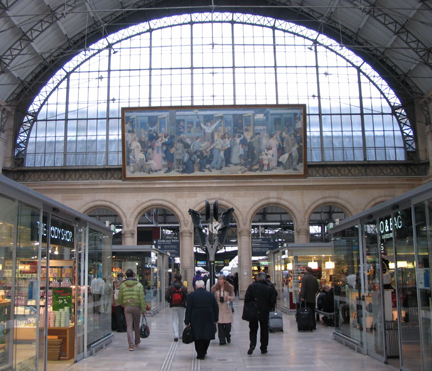
Whether you’ve got a ticket or not, the old (and renovated) train stations of Paris are worth a stop, such as here at Gare de l’Est, the East Station.
* * *
During my backpacking days in the early 80s, I developed a fondness for the bustle of European train stations, the excitement of currency change, the stock-broker-like fascination for the names up on the big board, the grandchild-like fascination with the old ladies in southern Europe who would watch your luggage for a small fee as you explored the city or went searching for a place to bed down, and the mild-to-pronounced seediness of the station neighborhood.
Each major station was different in that it represented that city or region or country yet clearly was connected with other places, people, and culture. Not only was the train station of Berlin or Paris or Belgrade or Rome specific in its own right, but the atmosphere of each lent itself to imagining stations, and all that went with them, elsewhere: Brussels, Amsterdam, Vienna, Rome, Prague, etc. Everywhere I went the grand station announced: You have arrived—and tomorrow you can be someplace totally different.

The early 80s was, in a sense, the tail end of post-war train travel, particularly in France with the arrival of the high-speed train or TGV that opened between Paris and Lyon in 1981. Extensions and new lines from Paris would follow: south to Nice, Montpellier, Bordeux; west to Brittany; north to Brussels and to London; east to Champagne, Lorraine and Alsace.
Paris is unique in Europe in that it sustains four train stations for long-distance regional and international traffic—Nord/North, Est/East, Lyon, and Montparnasse—and two for less distant regional traffic—St. Lazare and Austerlitz.
With each new tentacle of the TGV the corresponding train station in Paris has been renovated and modernized. The renovation of Gare de l’Est, the East Station, is the most recent of these.
Like other stations, Gare de l’Est and its surroundings have surrendered to progress the excitement, seediness, and currency exchange of French train stations as I remember them from the early 80s. What it has now is history, and a smooth ride to Lorraine and Alsace, and, for me, an easy walk home.



I love this train station, which is full of memories both happy (personal) and sad (historical). For me it is the beautiful, spacious and light-filled old building through which I travel when I am going between two places I love, Paris and Champagne. But there is also a very poignant, understated, and mostly overlooked memorial to the Jews who were deported from France from this station during WWII, etched into the wall of the station near the quais. I always take the time to read it again whenever I am there and I have time to spare.